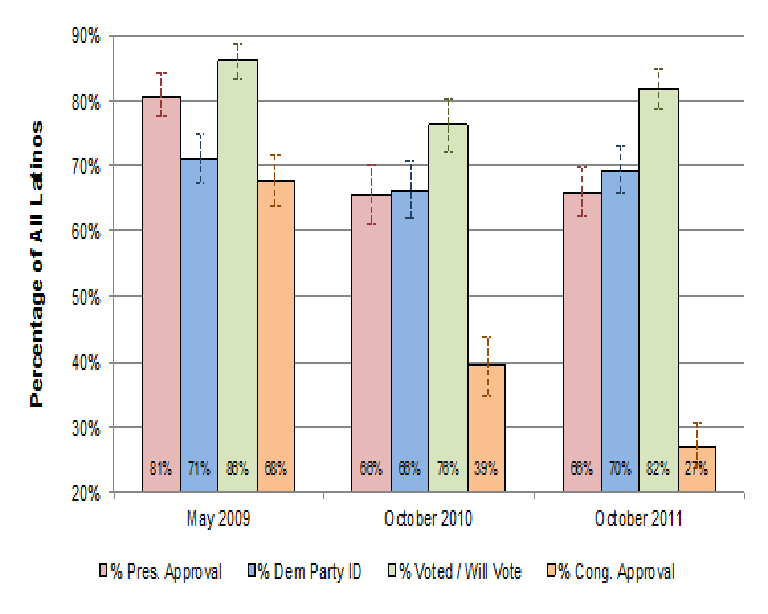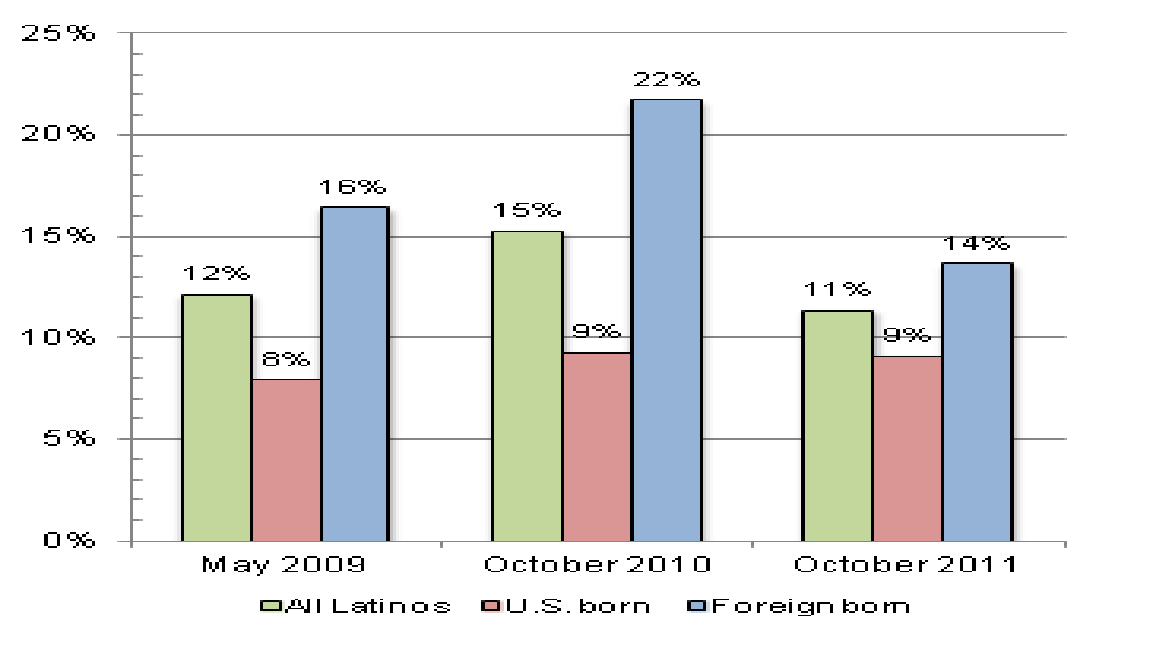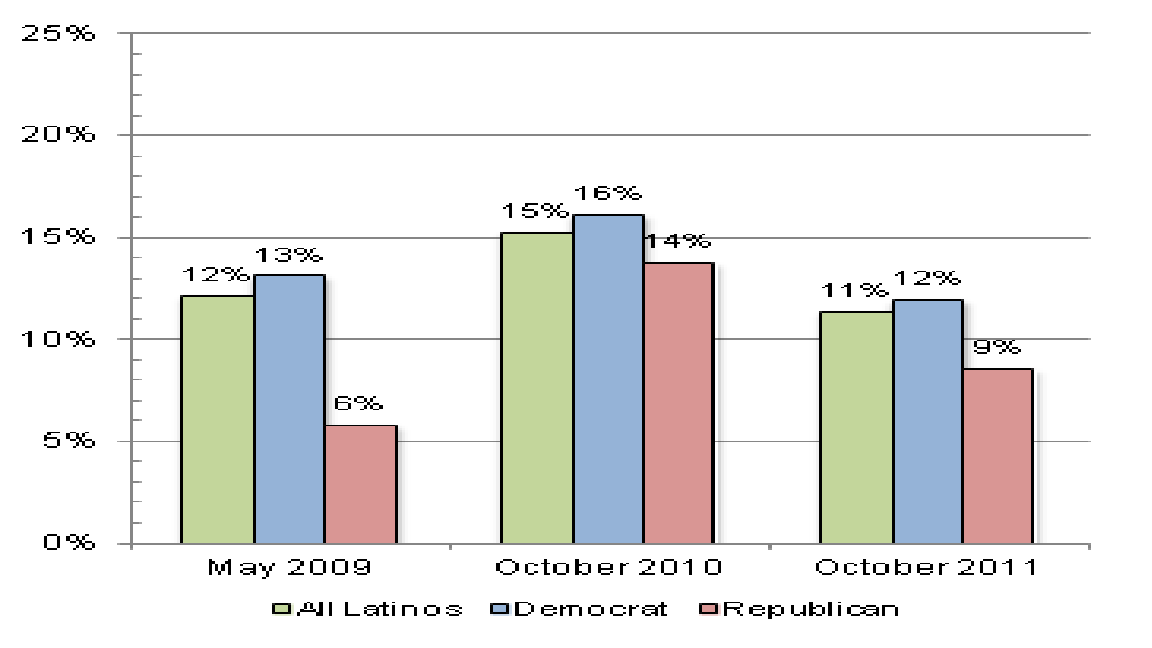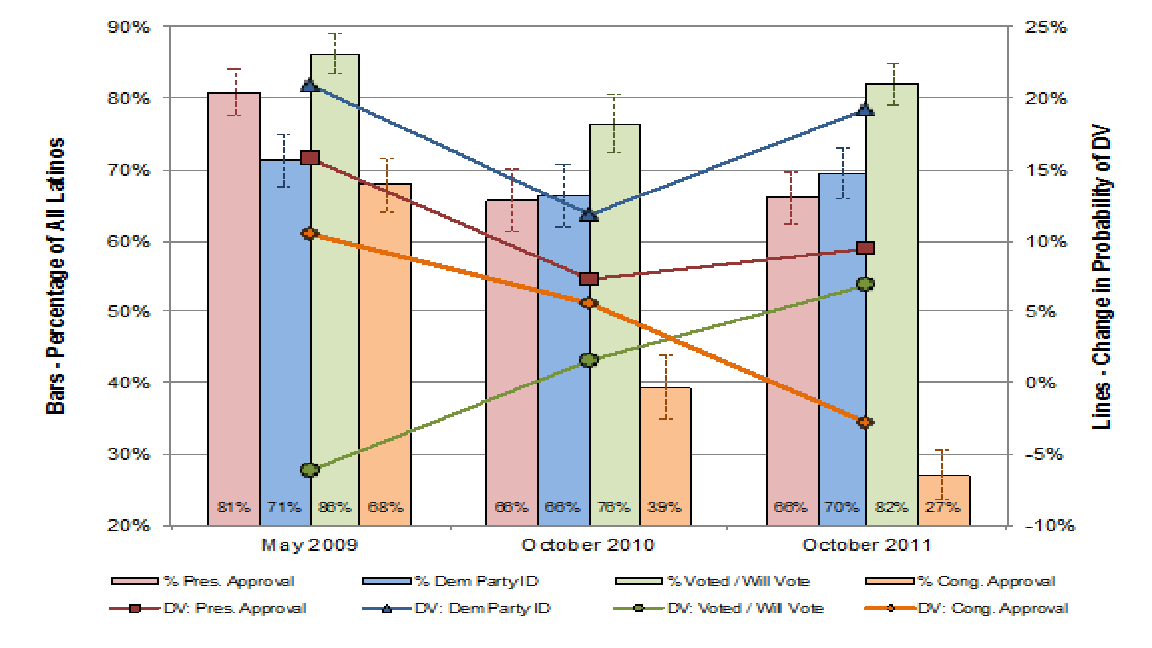By Ali A. Valenzuela, Assistant Professor of Politics, Princeton University
Will President Obama lose Latino voters in the 2012 election because of his administration’s immigration enforcement regime and lack of progress on comprehensive policy change? After failing to deliver on his campaign promises in this contentious policy area, President Obama has taken a hit in Latino approval of his job performance, but the president’s diminished numbers are much better than those of Congress. Figure 1 shows Latino voter approval of the president’s and Congress’s job performance in 2009, 2010 and 2011, as well as the percentage of Latino voters who identify as Democrats and indicate certainty of voting in those years.[1]
Figure 1. Latino Approval, Democratic Identification, and Likelihood of Voting
During each of the first three years of Barack Obama’s presidency, trends in Latino voter Presidential and Congressional approval, certainty of voting, and Democratic Party identification are closely linked to issue priorities and attitudes towards immigration reform. Latino voters who identify immigration reform as a top issue priority in 2011 are more certain to vote in the next election (2012) and more likely to identify as Democrats than comparably situated Latinos who identify other issues as their top priority. In contrast, Latinos who identify immigration reform as a top issue priority are no more or less likely than those who identify other issues as their top priority to approve of the job performance of the president and Congress.
These findings from 2011 represent a substantial weakening, since 2009, of the link between immigration reform and presidential or Congressional approval among Latino voters. Back in 2009, Latino voters who identified immigration reform as a top issue priority were significantly more likely than comparably situated Latinos, who identified other issues as their top priority, to approve of the President’s and Congress’s job performance. Trends from 2009 to 2011 also suggest that the issue of immigration reform has politicized Latinos into significantly greater certainty of voting, even as rates of Democratic Party identification have remained stable. This may be due to increased negative rhetoric emanating from the Republican primary contests, where all Republican challengers to President Obama have rejected proposals that include any possibility of citizenship. On this contentious issue, progressive Latinos have few alternatives to the Democratic Party, and this has resulted in robust party attachments despite weakening support for both the president and Congress.
Issue Priorities
Those who follow trends in Latino politics already know that Latinos consistently identify jobs and the economy, education and health care among their top issue concerns, tracking closely the priorities of other Americans. When the wars in Iraq and Afghanistan were at the top of the national policy agenda, these issues also registered among the top concerns of Latinos. In an article published in The Nation, Victoria M. DeFrancesco Soto, Ph.D., Director of Communications for Latino Decisions, argued that President Obama must appeal to Latino voters by persuading them on issues of jobs, economic recovery and educational investments. Latinos are a “multi-issue electorate,” she writes, and Obama “must recast his connection with Latino voters beyond a narrow focus on immigration.” Yet the issue of immigration policy is deeply important to Latino voters, often because of personal or family ties to the immigration experience.
Witness Latino opinion from November, 2011, when a Univision/Latino Decisions poll showed that 59% of Latino voters would be less likely to vote for a presidential candidate with an economic plan that they supported, if that candidate talked about undocumented immigration as a crime.[2] On the other hand, 75% of Latino voters would be more likely to vote for a candidate with an economic plan that they supported, if that candidate also talked about undocumented immigration as a matter of assimilation.[3] Stephen A. Nuño, Ph.D., contributor to Latino Decisions, unpacks these results in greater detail by examining partisan differences among Latinos and the general population. Overall, Latino voters are more likely to support candidates of either party who talk about undocumented immigration in a humane way that emphasizes immigrant accommodation by American society.
To better understand the importance of immigration reform compared to other policy areas among Latino voters over time, we can examine the issue priority question that is asked in most political polls. Although there is variation in question wording that limits some comparisons, respondents are usually asked to choose what they think is the most important issue of the day. This provides a gauge of how Latinos prioritize immigration reform relative to other policy areas; changes in the distribution of responses over time suggest how issue priorities may be shifting. With three years of data from Latino Decisions, we can examine year-to-year trends in issue priorities during President Obama’s first term in office and assess whether these trends also vary by nativity (foreign- and U.S.-born), partisanship (Democratic and Republican) or national ancestry (Cuban, Mexican and Puerto Rican).
The figures below show percentages of Latino registered voters who identify select issues (Figure 2) and immigration reform (Figures 3-5) as their top issue priority in 2009, 2010 and 2011. In May 2009, the top issue question asked Latino voters what they “think is the most important issue that President Obama and the new Congress should address during 2009,” while in October 2010 the question asked, “if the election for U.S. Congress were being held today, what general issues would be most important to you in deciding who to vote for?” The change in wording shifted the emphasis of the issue priority question from general concerns to specific concerns about vote choice. In 2011, the top issue question again focused attention on vote choice: “when it comes to deciding if you will vote, and who to vote for, what issues are the most important in how you evaluate the candidates and your decision to vote?”
Figure 2 shows that, overall, Latino issue priorities have remained fairly stable during three years of the Obama presidency. The most important issue area for Latino voters is jobs, unemployment and the economy, although this drops off substantially from a high of 61% in 2009, at the height of the economic crisis, to a low of 38% in 2010, before rising again to 47% in 2011. Immigration reform as a top issue priority hovers between 11 and 15% of Latino voters, larger percentages in all three years than those who identify health care or education as a top issue priority. The change in question wording from a “general top issue” in 2009, to the more specific “top issue for vote” wording in 2010 and 2011 may have artificially inflated the “other issues” category in these later years. This is because Latino voters may have other reasons in mind when deciding whether and for whom to cast a vote than when asked, generally, about their top issue concerns.
Figure 2. Latino Issue Priorities 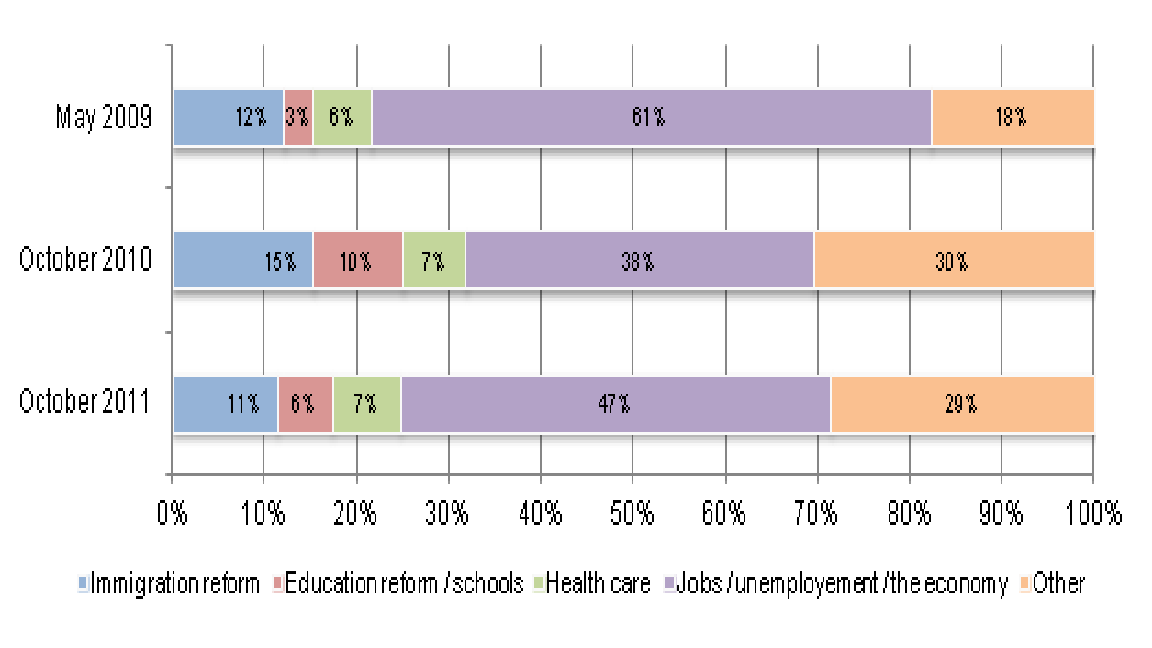
Examining next only those Latino voters who identify immigration reform as their top issue priority, we see in Figure 3 that foreign-born Latinos are consistently more likely than U.S.-born Latinos to identify this policy area as their top issue (statistical tests show these differences are significant with 99% confidence in 2009 and 2010, and with 90% confidence in 2011). Figure 4 shows that Democrats are somewhat more likely than Republicans to identify immigration reform as their top issue (significant difference with 99% confidence in 2009), but these differences are smaller than those between native- and foreign-born Latinos in all three years. In terms of national ancestry (See Figure 5), Mexican-origin Latinos (compared to those of Cuban or Puerto Rican ancestry) are the most likely to identify immigration reform as a top issue, with the greatest differences between Mexican and Puerto Rican Latinos (significant with 95% confidence in 2009 and 90% confidence in 2010).
Figure 3. Immigration Reform is Top Issue Priority, by Latino Nativity
Figure 4. Immigration Reform is Top Issue Priority, by Latino Party Identification
Figure 5. Immigration Reform is Top Issue Priority, by Latino National Ancestry
Using Latino Issue Priorities to Predict Approval, Democratic Identification and Likelihood of Voting
Trends in Latino issue priorities do not tell us how these priorities might correlate with presidential or Congressional approval, party identification or the likelihood of turning out to vote, nor how these relationships may have changed over the past three years. One way to paint a clearer picture of this process is to use statistical analysis to regress approval, Democratic identity and the likelihood of voting, separately, on issue priorities in all three years. Estimates from such regression models reveal the probability that comparably situated Latino voters, with particular issue priorities, approve of the job president Obama and Congress are doing, identify as a Democrat, and indicate certainty in voting. In other words, the models allow us to examine the correlation between these outcomes and issue priorities while simultaneously controlling for socioeconomic and other factors such as national origin and nativity that we have already seen are systematically related to which issues Latino voters select as their top priority.[4]
All of the models are specified with indicator variables for Latinos who identify immigration reform, education, health care, the economy, and the Iraq war as their top issue, with all other issue priorities serving as the omitted comparison category. Any significant coefficient on an issue priority means that compared to all other issues not included in the model, the significant issue is correlated with presidential or Congressional approval, Democratic Party identification, or the likelihood of voting. I do not claim a causal relationship between these outcomes and issue priorities, but a significant and positive relationship suggests that Latino voters who select this issue as their top priority are more likely to approve of the job President Obama or Congress is doing, more likely to identify as a Democrat, or more likely to say that they are certain to vote (in the 2010 and 2011 surveys) or that they voted previously (in the 2009 survey).
Instead of showing several tables of hard-to-interpret numbers, the results from this analysis are presented graphically in Figure 6. The figure shows several pieces of information together in order to ease comparisons across years. The bar chart is simply a copy of Figure 1, showing the percentage of Latino voters (on the left-hand axis) who approve of President Obama’s job performance (red bars), identify as a Democrat (blue bars), respond affirmatively to questions on past vote (in 2009) or certainty of future vote (in 2010 and 2011 surveys; green bars), and approve of Congress’s job performance (orange bars). The data show a significant 15 percentage-point decline in presidential approval from 2009 to 2011, although no difference between 2010 and 2011. There is a 10 percentage-point decline in the likelihood of voting between 2009 and 2010, with a small uptick in 2011, although this is not a significant increase. By contrast, Democratic Party identification remains fairly stable among Latino voters over the past three years, and Congressional approval drops dramatically among Latino voters, declining by 41 percentage-points from 2009 to 2011.
Figure 6. Predicting Latino Approval, Democratic Identification and Likelihood of Voting
Overlaid on the bar charts are solid colored lines that show results derived from the regression models of presidential approval (red line with red squares), Democratic Party identification (blue line with blue triangles), self-reported vote or certainty of voting (green line with green circles) and Congressional approval (orange line with orange diamonds). Recall that these dependent variables are regressed on issue priority indicators and individual control variables. The points on the solid lines represent changes in predicted probability (on the right-hand axis) of the dependent variables, calculated for each year separately.
Positive probabilities (above 0% on the right-hand axis) indicate an improvement in the likelihood of a dependent variable (Pres. Approval, Dem Party ID, Voted / Will Vote or Cong. Approval) resulting from changing a Latino voter’s top issue priority from all other issues to immigration reform, while holding individual characteristics constant.Negative changes in probability (below 0% on the right-hand axis) indicate the opposite: switching a Latino voter’s issue priority from all other issues to immigration reform decreases the likelihood of the dependent variable. Differences in the change in probability from year-to-year indicate weakening or strengthening of the relationship between immigration reform as a top issue priority and the dependent variable.
Two of the four regression plots show clear reversals in the relationship between selecting immigration reform as a top issue priority and the dependent variables: likelihood of voting and Congressional approval. In 2009, Latinos who identified immigration reform as their top issue priority were, relative to those who selected all other issues, about 6% less likely to say they had voted in the 2008 election, suggesting that this issue was not politically salient or that Latinos who identified this issue were less motivated to vote than other Latinos. By contrast, in October 2011, Latinos who identified immigration reform as their top issue priority were 7% more likely to say they are certain to vote in the 2012 presidential contest. As a political issue, immigration reform today is motivating Latino voters to the polls to an extent that it did not back in 2008.
The opposite pattern holds for Congressional approval. Latinos in 2009 who identified immigration reform as their top issue priority were about 10% more likely to approve of the job Congress was doing, while by October 2011, Latinos who identified immigration reform as their top issue priority are almost 3% less likely to approve of the job Congress is doing. This reversal over three years, a decline of 13% in the predicted probability of approving Congress among Latinos who identify immigration reform as a top issue, is clear evidence of the toll that Congressional inaction has done to Latino approval of the institution.
Regression plots of presidential approval and Democratic Party identification are more nuanced. In 2009, Latino voters who identified immigration reform as their top issue priority were almost 16% more likely to approve of the job President Obama was doing, but this declined to a low of 7% in 2010, before rising slightly to 9.5% in 2011. Over three years of his presidency, Barack Obama not only took a hit in the percentage of Latino voters who approve of his job performance (15 percentage-point drop), but those Latinos who identify immigration reform as a top issue priority are, by 2011, 6.5 percentage-points less likely to approve of his job performance than they were in 2009, even after controlling for important socio-demographic characteristics.
Although Democratic Party identification among Latino voters is similar in 2011 to what it was in 2009, the relationship between issue priorities and partisan identification fluctuates over the past three years of Barack Obama’s presidency. In 2009, Latino voters who identified immigration reform as a top issue priority were almost 21% more likely to identify as Democrats. This relationship declines to only 12% in 2010, before rising again to 19% in 2011. It may be that the looming presidential election, and the negative rhetoric on immigration reform coming from Republican candidates, has increased the salience and appeal of the Democratic Party on this important issue.
The same pattern of results from the regression analysis is evident from simple cross tabulations among Latino voters who identify immigration reform as their top issue priority. That is, even without any controls, among Latinos who identify immigration reform as a top issue, Congressional approval drops dramatically (48 percentage-point drop), past voting or certainty of future voting increases substantially (20 percentage-point increase), presidential approval declines (16 percentage-point drop, with the larger decline of 12 points between 2009 and 2010), and Democratic Party identification holds steady (only a 4 percentage-point decline). However, because of systematic differences in the characteristics of Latino voters who identify immigration reform as a top issue, we can have greater confidence in these trends by using regression models that control for individual characteristics.
Conclusion
Presidential politics, inaction on immigration reform, and increased action on immigration enforcement over the course of President Obama’s first three years in office have contributed to worsening attitudes towards the president and Congress among the Latino electorate. While Latino voter issue priorities have remained fairly stable over this time period, the relationships between issue priorities and presidential and Congressional approval, party identification, and the certainty of voting have moved considerably. Among Latino voters, the significant drop in presidential and Congressional approval since 2009 can be explained in part by issue priorities.
In October 2011, Latino voters who identified immigration reform as a top issue priority are substantially less likely to support the president and Congress compared to Latino voters who identified immigration reform as a top issue priority in May 2009. Additionally, support for the Democratic Party among these Latino voters is soft, fluctuating with the dynamics of the electoral cycle and, perhaps, waiting for genuine action on immigration reform before stabilizing from election-to-election. Importantly, immigration reform as an issue priority in 2011 appears to have politicized Latinos into significantly greater certainty of voting than it did in 2008. This may be a silver lining in the strict enforcement regime of the Obama administration since, even if his job approval is diminished among Latino voters since 2009, there appears to be little decline in the likelihood of Latino Democratic identification. In this case, the overheated and highly negative rhetoric of the Republican presidential candidates may be driving a newly invigorated Latino electorate back into President Obama’s corner for the 2012 general election contest.
Footnotes
[1]Latino Decisions collected opinion data from registered Latino voters, living in at least 20 states, using bilingual telephone interviews conducted in May 2009, October 2010 and October 2011. These data are broadly representative of the U.S. Latino registered voter population; all reported results account for complex sampling designs of the surveys and use national probability weights in order to adjust the samples to match state-level population characteristics. This research was conducted with financial support from Stanford and Princeton universities.
[2] The question asked Latino voters, “Let’s say one of the candidates had a plan to improve the economy that you supported, and on the immigration issue the candidate said, quote: ‘illegal immigrants are a threat to America who have committed a crime, we can never support amnesty for illegals.’ Would that statement make you more likely to support the candidate, less likely to support the candidate, or would you not care what they said about immigration if you agreed with their plan for the economy?”
Ali A. Valenzuela is an Assistant Professor of Politics at Princeton University and can be reached at: [email protected]
The commentary of this article reflect the views of the author and do not necessarily reflect the views of Latino Decisions. Latino Decisions and Pacific Market Research, LLC make no representations about the accuracy of the content of the article.

